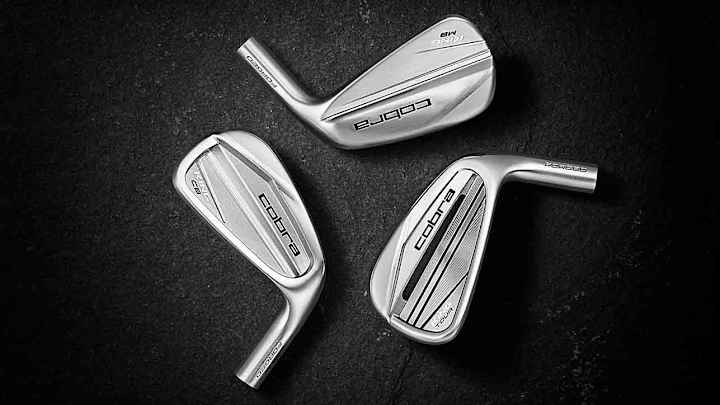Cobra Further Stakes a Claim Atop the Game With New King Irons

ORLANDO, Fla. — On the list of the best drivers I’ve ever owned, the King Cobra SS 427, circa 2002, is right near the top.
That club was hot. The golf ball catapulted off its face. It felt incredibly powerful. Even better, it was loud at contact. When I hit balls with it at a large indoor golf dome in the Pittsburgh area, the sound was like a gunshot. Heads would turn.
So I was extremely disappointed later that decade as the brand slowly shriveled away under the ownership of Titleist, turning Cobra from a rival into a niche brand of oversized-head clubs for seniors and women.
When Cobra was sold off to Puma in 2010, it broke out orange-colored driver heads in honor of Rickie Fowler, staff professional and official Ambassador of Orange. That’s when I stopped taking Cobra seriously.
Thirteen years later, I’ve never been so happy to be so wrong.
I thought the orange clubs—“creamsicles,” as some called them—were cheesy. Actually, they were the signal of a Cobra turnaround. Titleist, which let the Cobra brand flounder and fade away, sold the brand to Puma, the shoe and apparel company.
“After that sale happened, our president, Bob Philion, wanted to make changes to let people know Cobra was being reborn,” said Jose Miraflor, a Cobra product architect. “That orange was strong and overwhelming to make a statement. We’re more subdued now. So is Rickie, who’s more mature. He doesn’t wear orange all the time, either.”
Cobra slowly got back into the game (without me noticing) and now, it’s a big player again. The company showed off its innovative side a few years ago with the Bryson DeChambeau-inspired ONE-Length irons, a set of clubs all the same length, just like what DeChambeau plays.
This year, Cobra has an all-new lineup on display at the PGA Merchandise Show at the Orange County Convention Center.

All you need to know about the new Cobra King Tour irons ($1,299 suggested retail) is they are winners. I tried them out at an indoor golf dome in Pittsburgh before this week, then played three rounds here in Florida before the PGA Show. I don’t change irons often and the clubs that were in my starting lineup were only two years old, but the King Tour irons are that good. They’re in the bag. It was an easy decision.
You can get fooled hitting balls off indoor mats but the King Tours were even better outdoors when I finally got the chance. It’s simple stuff that’s hard to explain. They’ve got that Goldilocks-like feel—not too firm, not too soft, just right.
And there’s a visual factor you can’t underestimate. The King Tours feature a thin topline (by modern standards) and when you look down at them at address, they look like clubs you want to hit. There’s something to be said for confidence even if it’s based on cosmetics. And on the other hand, bad cosmetics—like an unusually thick topline—are an instant turn-off that you may not ever get over mentally.
Here’s a quick overview of the science behind these Cobra clubs: Most manufacturers use a four-step forging process. Cobra adds a fifth step that involves subjecting each iron head to 2000 tons of pressure at 700 degrees Celsius. You probably forgot what you learned in seventh-grade science class about converting Fahrenheit temperatures to Celsius. Don’t worry, 700 degrees Celsius isn’t volcano-lava hot … but it’s close.
Cobra says the benefits of five-step forging include precise shaping, better weight tolerances, improved face-thickness consistency, better aesthetics and significantly enhanced feel at impact. Translation: Technology that gives you a better playing experience.
I can’t vouch for the science, but I can vouch for the feel. I like the way the King Tour heads look—sleek with diagonal lines intersected by a long ridge. They have a clean, cutting-edge appearance. My set came with KBS $-Taper 120 steel shafts.
My first two rounds in Florida found me in the middle of my winter offseason. I hit just enough OK shots to be encouraged. On the third round, the wind blew 25 mph on a challenging course and I had to play—or try to play—a variety of shots. I hit some lower knockdown shots, some medium-height bore-through-the-wind shots and one or two hoist-it-up-to-the-jet-stream shots.
It was a rare day in a tournament situation where I felt like a real golfer again, and the King Tours played a big role in that.
Clearly, Cobra has something going on. The irons also come in a muscleback version and, if you’re so inclined (and need a little more game improvement in long irons), you can get a mixed set of musclebacks and cavity backs.
I haven’t hit the new drivers in the Aerojet series, but they look compelling. The driver’s crown is a kind of carbon-fiber mesh. The base of the head has a few small splashes of color in blue, red and white, and there are adjustable weights. The head has a larger, more forgiving face than its predecessor, which accounts for better aerodynamics that resulted in a 1.3 mph gain in clubhead speed in Cobra’s testing.
Cobra has made quite an upward move since the end of its Titleist servitude. Better applied technology, better player-friendly clubs and a higher brand profile.
Asked how many orange shirts he has in his closet, Miraflor said, “At one point, maybe up to 10. Now? Zero. We don’t do orange now.”
Now, with all due respect to The Color Orange, it is Cobra’s high-performance quality that gets your attention.
